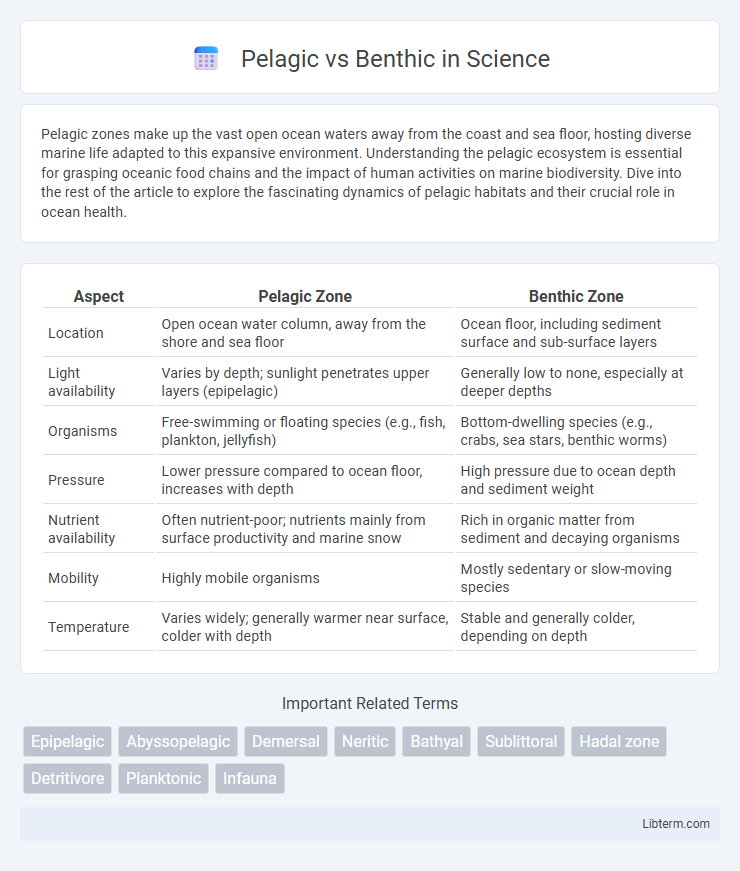Pelagic zones make up the vast open ocean waters away from the coast and sea floor, hosting diverse marine life adapted to this expansive environment. Understanding the pelagic ecosystem is essential for grasping oceanic food chains and the impact of human activities on marine biodiversity. Dive into the rest of the article to explore the fascinating dynamics of pelagic habitats and their crucial role in ocean health.
Table of Comparison
| Aspect | Pelagic Zone | Benthic Zone |
|---|---|---|
| Location | Open ocean water column, away from the shore and sea floor | Ocean floor, including sediment surface and sub-surface layers |
| Light availability | Varies by depth; sunlight penetrates upper layers (epipelagic) | Generally low to none, especially at deeper depths |
| Organisms | Free-swimming or floating species (e.g., fish, plankton, jellyfish) | Bottom-dwelling species (e.g., crabs, sea stars, benthic worms) |
| Pressure | Lower pressure compared to ocean floor, increases with depth | High pressure due to ocean depth and sediment weight |
| Nutrient availability | Often nutrient-poor; nutrients mainly from surface productivity and marine snow | Rich in organic matter from sediment and decaying organisms |
| Mobility | Highly mobile organisms | Mostly sedentary or slow-moving species |
| Temperature | Varies widely; generally warmer near surface, colder with depth | Stable and generally colder, depending on depth |
Introduction to Pelagic and Benthic Zones
Pelagic zones refer to the open water areas of oceans and seas, extending from the surface to the deep ocean, inhabited by free-swimming organisms like fish, plankton, and marine mammals. Benthic zones encompass the ocean floor, including the sediment surface and sub-surface layers, home to bottom-dwelling species such as crabs, starfish, and bacteria. These zones differ significantly in light availability, pressure, and biodiversity, shaping unique ecological communities.
Defining Pelagic Environments
Pelagic environments refer to the open water zones of oceans and seas, extending from the surface to the deep ocean layers, where organisms live suspended in the water column rather than on the seafloor. These habitats support diverse marine life adapted to varying light, pressure, and nutrient conditions, including plankton, fish, and marine mammals. Understanding pelagic zones is essential for studying oceanic ecosystems, fisheries, and biogeochemical cycles.
Understanding Benthic Habitats
Benthic habitats are ecological regions found on the ocean floor, including continental shelves, slopes, and abyssal plains, characterized by organisms adapted to life in sediment or attached to substrates. These environments support diverse communities such as polychaetes, crustaceans, and benthic fish, playing a crucial role in nutrient cycling and carbon sequestration. Understanding benthic habitats is essential for assessing marine biodiversity, ecosystem health, and the impacts of human activities like trawling and pollution.
Key Differences Between Pelagic and Benthic Zones
Pelagic and benthic zones are distinguished primarily by their location within aquatic environments; the pelagic zone encompasses the open water column away from the bottom, while the benthic zone refers to the ocean floor and sediment surface. Organisms in the pelagic zone, such as plankton and nekton, are adapted to swimming and floating, contrasting with benthic species like crabs and sea stars that live on or within the seabed. Light penetration, pressure, and nutrient availability differ significantly between these zones, influencing ecological dynamics and biodiversity.
Adaptations of Pelagic Organisms
Pelagic organisms exhibit adaptations such as streamlined bodies and powerful swimming capabilities to navigate open water efficiently. They possess buoyancy control mechanisms like gas-filled swim bladders or lipid storage to maintain vertical position in the water column. Sensory adaptations include enhanced vision and lateral line systems to detect prey and predators in the vast pelagic environment.
Adaptations of Benthic Organisms
Benthic organisms exhibit unique adaptations such as enhanced attachment mechanisms, like suction cups and strong claws, enabling them to anchor firmly to substrates in turbulent environments. Many possess specialized respiratory structures, including gills adapted for low-oxygen conditions typical of seabed habitats. Morphological features like flattened bodies and camouflaged exoskeletons improve their ability to evade predators and thrive within the sediment-rich benthic zone.
Ecosystem Roles: Pelagic vs Benthic Species
Pelagic species inhabit the open water column, playing crucial roles in nutrient cycling, carbon sequestration, and serving as key prey for larger marine predators. Benthic species dwell on or within the seabed, contributing to sediment stabilization, organic matter decomposition, and habitat complexity that supports diverse marine communities. The contrasting ecosystem roles of pelagic and benthic species highlight their complementary functions in maintaining ocean health and biodiversity.
Importance in Marine Food Webs
Pelagic and benthic zones play crucial roles in marine food webs by supporting different communities of organisms that drive energy flow and nutrient cycling. Pelagic organisms, such as plankton and fish, inhabit open water and form the base of food chains through primary production and consumption by higher predators. Benthic species, including detritivores and bottom-dwelling invertebrates, facilitate decomposition and nutrient recycling on the ocean floor, sustaining diverse ecosystems and connecting with pelagic systems through organic matter transfer.
Human Impacts on Pelagic and Benthic Ecosystems
Human impacts on pelagic ecosystems include overfishing, pollution from plastics and chemicals, and climate change-induced ocean warming, which disrupt marine food webs and reduce biodiversity. Benthic ecosystems face habitat destruction from bottom trawling, sedimentation from coastal development, and contamination by heavy metals and toxins, leading to declines in benthic species and altered sediment chemistry. Both ecosystems suffer from nutrient loading and hypoxia driven by agricultural runoff, causing dead zones that impair ecosystem services and fisheries productivity.
Conservation Strategies for Pelagic and Benthic Zones
Conservation strategies for pelagic zones emphasize mitigating overfishing and minimizing plastic pollution by implementing sustainable fishing practices, marine protected areas, and reducing marine debris through international agreements. Benthic zone conservation focuses on habitat restoration, controlling bottom trawling activities, and protecting sensitive seafloor ecosystems such as coral reefs and hydrothermal vents through legal regulations and monitoring programs. Both zones benefit from integrated ocean management plans that incorporate scientific research, community engagement, and adaptive policies to ensure long-term ecosystem resilience.
Pelagic Infographic

 libterm.com
libterm.com